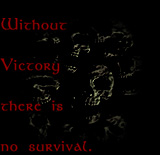|
|
 |
 |


Deck Talk
7.22.04
OK, I want to start out
by saying thanks for the positive e-mails. I've been
getting several and I enjoy each and every one of them.
However, lately, I've been getting a lot of e-mails
regarding players decks and how to help those decks.
I'm seeing two things over and over that need to be
addressed. There is no secret to just building a good
deck. It seems as though many of you think there is some
secret that we possess that allows us to create great
decks. Believe me, if I had the secret blueprints on
building superior decks, I would be selling it on ebay!
There are some concepts and ideas that can help deck
creation along, but definitely no rules set in stone.
The rules that you do you use will depend on what type
of deck you are building. If you are building an
aggressive (also known as "aggro") deck, then you are
definitely going to want more creatures than spells. You
will then have to look at the type of creatures in the
deck. If you want the deck to be super fast, you want a
bunch of cheap creatures with high power or high damage
potential. Creatures like Slith Firewalker fit this
category. For other aggro decks, you want quick spells
with bigger creatures. The combo of Oxidize and Ravenous
Baloth might fit this style of deck better. On the
opposite end of the spectrum though, you may want fewer
creatures with more efficient spells. Cards that do more
for less are needed in these types of decks. Cards like
Wrath of God and Thirst for Knowledge have become
staples in decks like Blue/White Control.
Now, those are just some conceptual aspects of what you
need to ponder when deck building. But, that all means
nothing if the cards aren't that great in the deck. This
brings me to my next point. For example, Paul Hagan (our
resident Deck Garage guy) and myself were discussing
some e-mails that had been sent to us. We had each seen
several decks that included Myr Servitor. Well, that's
the first thing we each told people to take out of their
decks. It has next to no purpose.
When go to deck build, cards like this are not needed.
First of all, they are extremely linear in their usage.
They don't lend any help to anything else. Then, beyond
that, it doesn't really DO anything until you already
have other Myr Servitors in the graveyard to bring back
to play. This means that not only are you dedicating
four slots to Myr Servitor, but you have potentially
dedicated another two to five slots to getting the
Servitors in the graveyard. THEN as if that weren't
enough, you would still need your other card that makes
that makes the Servitors ability useful. This would most
likely be something that you could sacrifice creatures
to. So, we can then say another four cards are put in
these slots. So this means that if you are trying to
build a deck to effectively use Myr Servitor, you have
already given up roughly 11 to 12 slots not even
counting your lands. So half your deck is already
dedicated to making this card work. This sounds extreme,
but there's no point to play the card if you aren't
going to try and make effective use of its ability. The
down side is that even after we've put this deck
together, it doesn't work. Why? Simple, the Myr Servitor
dies to nearly every damage spells, removal spell, and
artifact kill spell in the game. In other words, he's a
liability.
This sound silly, but if you at least take the time to
look at the cards objectively when building, you can
save yourself a lot of time and headaches. Cards need to
be cohesive in order to make a deck work. They need to
compliment each other in working toward a purpose. If
they don't, you will end up with a deck that basically
has a lot of cards doing a bunch of different things OK,
but not doing any one thing well.
Even with all that knowledge, the deck you build still
may not be good enough. I know, sounds crazy right? I'll
let you in on another secret. Most of the decks I build
don't stay built as they are when I first put them
together. Decks go through a lot changes. You have to
test a lot. You have to play a lot. You might find that
something isn't as great as you thought it was going to
be. You might find out that some cards aren't as strong
against certain other decks. You might even discover
that you misjudged the effectiveness of something. Some
cards may merit more slots. There are some cards you may
want to draw less of, thus giving them less slots.
And that brings us to another point. Decks can't be
allowed to go stale. Just because a deck has won a
tournament or that a deck has done well, doesn't always
mean that is the best version. It might be the best
version for a particular deck. It might have even been
the best deck at a particular tournament. However, you
have to be aware that tournament environments change.
Right now, Standard (Type 2) is more variable than it
has ever been. Nearly every color and every deck type is
in perfect parody these days. This means that you have
to keep working on making your deck better. Don't make
any drastic changes. Just keep notes from games to game.
When some matches start getting tougher, find out why
and work on changes those matchups.
There used to be a saying among the old players
regarding two "netdeckers." It basically stated that the
guy who got his deck on Tuesday is going to lose to the
guy that got his deck on Friday. There is some knowledge
in that statement. The logic is that the deck posted on
Friday is has accounting for some last minute changes
and surprises. Sometimes, that is all the difference you
need to win a matchup.
As you can see, it takes a lot to build good decks and
keep them at a competitive level. Truthfully, every
Magic player possesses the ability to build good decks.
You just need to learn how to observe cards and their
synergy. I hope this helps open your thoughts a bit on
the creative processes of deck building.
But before I go, let me post a Mirrodin Block
Constructed Red deck for you all. It's an Affinity deck
WITHOUT Myr Servitor. Since most of the decks we see
with the Servitor are Affinity, I figured I would post a
good one.
4 Arcbound Ravager
4 Arcbound Worker
4 Disciple of the Vault
4 Frogmite
4 Somber Hoverguard
4 Pyrite Spellbomb
4 Cranial Plating
4 Shrapnel Blast
4 Thoughtcast
4 Welding Jar
4 Darksteel Citadel
4 Glimmervoid
4 Great Furnace
4 Seat of the Synod
4 Vault of Whispers
Sideboard:
4 Damping Matrix
4 Electrostatic Bolt
2 Island
3 Qumulox
2 Terror
Until next time,
DeQuan Watson
a.k.a. PowrDragn
PowrDragn at Pojo dot com
|



